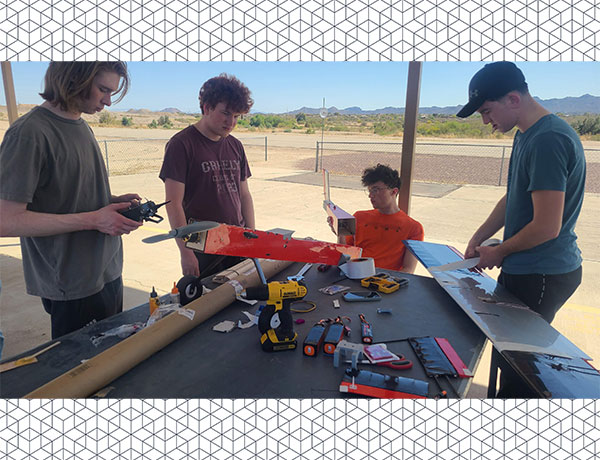
In a University “first,” the team, led by Associate Professor Paul Slaboch, participated in the Design-Build-Fly competition by the American Institute of Aeronautics and Astronautics.
Held in Tucson, Arizona, this year’s event marked the 29th annual competition and the largest flyoff to date, attracting more than 1,200 students from 97 university teams across 13 countries and 34 states.
UHart’s participation was able to get off the ground thanks to a $25,000 sponsorship from Lockheed Martin. “The generosity of Lockheed Martin made this whole experience possible and has set us up for continued success and improvement in the years to come,” Slaboch says.
The competition challenged student teams to design, build, and fly a remote-controlled plane that could also launch a glider. The glider was designed to simulate the X-1 test vehicle from the early days of supersonic flight – but with “fuel tanks” made from 16-ounce beverage bottles and carrying sand or water to represent “fuel.” The glider also needed to have flashing lights so it would be visible from the ground.
The students were given three “missions” to fly, including one in which they had to convert the airplane to carry the glider within 5 minutes.
Most of UHart’s team were first-, second-, or third-year students, well beyond the one-third minimum required by the competition rules. Most had never built or designed a remote-controlled aircraft before. The team consisted of:
- Dante Bergantino (Pilot) – 3rd year Aerospace Engineering
- Christian Piscitelli and Tucker Rice – 3rd year Aerospace Engineering
- Liam Gordon – 2nd year Mechanical Engineering
- Jack Heffernan – 1st year Aerospace Engineering
They were supported by Steven Yon, Makeline Adam, Drew Lauzier, Michael Langone, Kiden Scruton, Peter Cardenas, and Bryce Roberts, all aerospace engineering majors ranging from first to fourth year.
Paul Slaboch, CETA Associate ProfessorWe’re incredibly proud of what this team accomplished. They’ve started something special, and I can’t wait to see how far they’ll fly next year.
In Tucson, the team conducted trial flights at a local airstrip to be sure their craft could perform well in the desert heat. Then they had to make it through a technical inspection, which nearly half the teams failed on the first attempt. The UHart team passed on their second try.
It wasn’t all smooth sailing, though. During the Ground Mission phase, the team was able to configure their aircraft to carry and release the X-1 glider and external tanks. However, an issue with the glider’s lights not flashing correctly resulted in a mission failure. Despite this, the team remained eligible to attempt flight missions.
Their first Flight Mission was both thrilling and challenging. Pilot Dante Bergantino maneuvered the aircraft through the required laps and landed successfully, even after losing the left aileron mid-flight. Though the aircraft met the mission profile, the loss of a component disqualified the flight.
Undeterred, the students rebuilt the aileron, passed Tech again, and returned to the flight line for another attempt. Unfortunately, the aircraft’s landing gear collapsed just off the runway during landing, ending the mission just short of scoring.
The UHart team didn’t walk away with a final mission score – only 16 of the 112 teams completed all four missions – but they did gain experience, resilience, and connection, forging relationships with teams from around the world. They learned to solve real-world engineering problems under pressure, with quick thinking, technical skill, and teamwork. And they laid a strong foundation for future success.
“We’re incredibly proud of what this team accomplished,” said Slaboch. “They’ve started something special, and I can’t wait to see how far they’ll fly next year.”